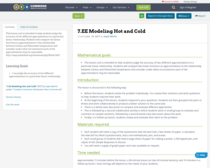Learning Domain: Expressions and Equations
Standard: Solve multi-step real-life and mathematical problems posed with positive and negative rational numbers in any form (whole numbers, fractions, and decimals), using tools strategically. Apply properties of operations as strategies to calculate with numbers in any form; convert between forms as appropriate; and assess the reasonableness of answers using mental computation and estimation strategies. For example: If a woman making $25 an hour gets a 10% raise, she will make an additional 1/10 of her salary an hour, or $2.50, for a new salary of $27.50. If you want to place a towel bar 9 3/4 inches long in the center of a door that is 27 1/2 inches wide, you will need to place the bar about 9 inches from each edge; this estimate can be used as a check on the exact computation.
Degree of Alignment:
3 Superior
(1 user)
Cluster: Solve real-life and mathematical problems using numerical and algebraic expressions and equations
Standard: Solve multi-step real-life and mathematical problems posed with positive and negative rational numbers in any form (whole numbers, fractions, and decimals), using tools strategically. Apply properties of operations as strategies to calculate with numbers in any form; convert between forms as appropriate; and assess the reasonableness of answers using mental computation and estimation strategies. For example: If a woman making $25 an hour gets a 10% raise, she will make an additional 1/10 of her salary an hour, or $2.50, for a new salary of $27.50. If you want to place a towel bar 9 3/4 inches long in the center of a door that is 27 1/2 inches wide, you will need to place the bar about 9 inches from each edge; this estimate can be used as a check on the exact computation.
Degree of Alignment:
3 Superior
(4 users)



on Oct 14, 04:11pm Evaluation
CCSS.Math.Content.7.EE.B.3: Superior (3)
The lesson addresses the real-life conversion of Celsius to Fahrenheit. The lesson fully explores real-life situation in which students must use mathematical reasoning to reach reasonable conclusions.
on Oct 14, 04:11pm Evaluation
Utility of Materials Designed to Support Teaching: Strong (2)
The lesson and materials for students use are comprehensive and relatively easy to understand. The lesson falls short in addressing differentiation. However, after the pre-lesson, the teacher can assign collaborative groups based on student responses.
on Oct 14, 04:11pm Evaluation
Quality of Instructional and Practice Exercises: Strong (2)
This lesson provides students the opportunity to apply their foundational skills of mathematical concepts to predict and evaluate. This is a challenge lesson/activity and a culmination of prior exercises to support skill acquisition.
on Oct 14, 04:11pm Evaluation
Quality of Assessments: Superior (3)
The assessment is two-fold. The lesson challenges students' analytical reasoning by engaging them in critical thinking. The second part of the assessment integrates English language arts into the math curriculum. Students are required to explain and defend their conclusions in a written format.
on Oct 14, 04:11pm Evaluation
Quality of Technological Interactivity: Limited (1)
There is a PowerPoint which provides a slide to introduce the lesson and 2 slides to use during the lesson. These address steps for the planning and evaluation during the lesson. However, the lesson does not engage students on an interactive lesson.
on Oct 14, 04:11pm Evaluation
Quality of Explanation of the Subject Matter: Strong (2)
The subject matter was explained well. The visual aid, in the way of the PowerPoint, was clear and concise except in one area. The visual for the expression to convert from Celsius to Fahrenheit could be confusing. Suggest the teacher fully explain the expression to alleviate any confusion leading to students not being successful. The sample responses engage students in critical thinking and analysis.
on Oct 14, 04:11pm Evaluation
Opportunities for Deeper Learning: Superior (3)
This lesson engages students in critical thinking, analysis, collaborative interaction, and reciprocal teaching. Students were challenged with making predictions, creating responses, discussing and evaluating those responses, reviewing then reflecting. Students are required to construct a written response in which they must state the problem, their findings, and support their claims in written form. The lesson blends mathematical concepts with English language arts curriculum.
on Nov 24, 09:16am Evaluation
CCSS.Math.Content.7.EE.B.3: Superior (3)
This problem requires solving the real life conversion of Celsius to Fahrenheit and tasks students to assess the reasonableness of given short-cut methods (e.g.estimations/strategies).
on Nov 24, 09:16am Evaluation
Utility of Materials Designed to Support Teaching: Superior (3)
The resource includes common issues students may encounter in solving this problem along with suggested questions and prompts to support a variety of learners and problem solving strategies. Lesson is sequenced and chunked with specific suggestions for each segment of the lesson.
on Nov 24, 09:16am Evaluation
Quality of Assessments: Strong (2)
The follow-up lesson acts as a student reflection rather than as a way for students to demonstrate proficiency in the intended concept/skill.